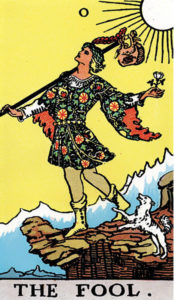Welcome to Mythology Monday!
As yet another recurring Monday theme, the second Monday of each month will be Mythology Monday here at the Fool’s Bag. Mythology is one of my favorite topics, so of course I’m all over the connections between mythology and the Tarot! For this first post in the series, we’ll be looking at the connections between mythology and the Tarot in general, then moving into today’s topic: The Fool’s Journey.
Mythology and the Tarot
In some ways, the Tarot is its own mythology. The Fool, the Magician, the Empress and Emperor, the World Dancer, and others could all be considered gods in the pantheon of Tarot. While these figures lack the body of written stories the gods of other world mythologies, they nonetheless have their own identities and backstories, and a broad myth tying them all together: The Fool’s Journey.
But beyond its own story, the figures, symbols, and implied stories in the cards include countless parallels to other mythologies as well. We can see any number of Earth and Mother goddesses in the figure of the Empress, for example. We find Mercury’s Caduceus symbols on the two of Cups, the Egyptian Sphinx on the Chariot, and the symbol for Venus on the Empress.
In this ongoing series, we’ll look at the symbolism and connections between the Tarot and various world mythologies. We’ll be approaching the subject from many angles, and covering a wide range of topics.
To get us started, let’s take a high-level overview of The Fool’s Journey!

The Fool’s Journey: An Overview
The Fool’s Journey begins with the Fool, representing our untapped potential and the spirit of adventure that propels us into the unknown. As the Fool progresses through the Major Arcana, he encounters characters and situations that represent different aspects of the human experience. The journey culminates with The World, symbolizing the completion of a cycle and the attainment of enlightenment.
Mythological Parallels in the Fool’s Journey
Throughout the Fool’s Journey, we find striking parallels with various mythological stories and archetypes. These connections help deepen our understanding of the Tarot and reveal universal themes that resonate across cultures and traditions. Here are a few examples:
The Fool and the Hero’s Journey: The Fool’s Journey shares many similarities with the Hero’s Journey, a narrative pattern identified by scholar Joseph Campbell in his book “The Hero with a Thousand Faces.” In both the Fool’s and Hero’s Journeys, the protagonist embarks on an adventure, faces trials and tribulations, and ultimately experiences a transformation. This parallel highlights the universal nature of the human quest for self-discovery and spiritual growth. I’m a huge fan of Campbell; no doubt you’ll be seeing his name often on Mythology Mondays!
The Magician and the Trickster: The Magician card represents the power of creation and transformation, symbolizing our ability to shape our reality through intention and will. This card has parallels with the Trickster archetype found in many mythologies, such as Loki in Norse mythology or Coyote in Native American folklore. The Trickster is a figure who uses cunning and deception to challenge the status quo and initiate change, mirroring the Magician’s ability to manifest new possibilities.
The High Priestess and the Oracle: The High Priestess card is a symbol of intuition, mystery, and the subconscious mind. This card has strong connections to the mythological figure of the Oracle, such as the Pythia at the Temple of Apollo in Delphi. The Oracle served as a mediator between the divine and human realms, offering wisdom and guidance through visions and prophecies. Similarly, the High Priestess encourages us to access our inner wisdom and trust our intuition.
The Hanged Man and the Dying and Resurrecting God: The Hanged Man represents surrender, sacrifice, and the need to see things from a new perspective. This card shares parallels with the mythological motif of the dying and resurrecting god, such as Osiris in Egyptian mythology or Jesus in Christian tradition. These deities undergo a symbolic death and rebirth, illustrating the transformative power of surrender and the potential for renewal that lies within us all.
Integrating Mythology into Your Tarot Practice
There are many ways to use mythology to expand and deepen your relationship with and use of the Tarot. Here are a few ideas and suggestions:
- Study the mythological parallels in the Tarot, examining how these stories and archetypes inform the meanings of the cards. You’ll be seeing plenty of these examples here at The Fool’s Bag as this series continues.
- If you read for others, you can use myths to help explain the meaning of key cards in a reading. Sometimes sharing a story can help a person to understand and apply the lesson the cards are trying to teach. It can also make the reading more interesting and entertaining for the querent, and make you look like a wise elder, full of stories!
- Meditate on the Tarot cards and their mythological connections, allowing your intuition to guide you towards a deeper understanding of the cards’ meanings and the lessons they hold.
Conclusion
By exploring the mythological parallels and connections within the Tarot, we can gain valuable insights into the universal themes and archetypes that shape our lives, fostering a deeper connection to our inner wisdom and the collective human experience. Mythology, and specifically The Fool’s Journey, offers a powerful framework for understanding our spiritual journey and the challenges, lessons, and transformations we encounter along the way. As you continue your own Fool’s Journey, allow the rich tapestry of mythology to illuminate your path, guiding you towards greater self-discovery, growth, and enlightenment.

